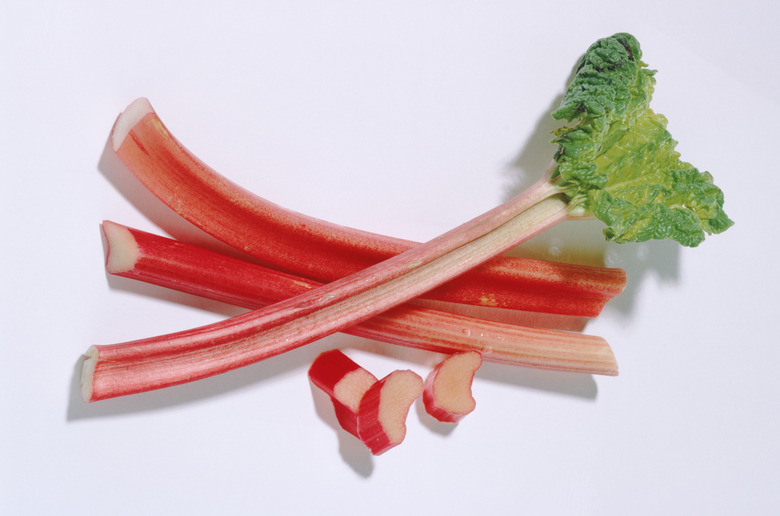Are There Other Plants That Look Like Rhubarb?
Birds, the wind and other animals can spread seeds to various areas of your yard or garden. If you see a plant that looks like rhubarb and you're not sure if it is, beware. There are other plants that look similar to rhubarb, but are toxic lookalike plants that are inedible. Some can make your children and pets quite sick.
Identification
Step 1
Rhubarb (Rheum rhabarbarum) is an easy-to-grow perennial plant in U.S. Department of Agriculture plant hardiness zones 3 though 8. The plant produces thick, red solid stalks that can grow up to 5 feet tall, topped with large, elongated, heart-shaped leaves. Plant grows white, spikelike flower clusters, which are insignificant. Rhubarb leaf stalks have a tart flavor. Stalks are often harvested and used in baking, and you can also grow rhubarb as edible landscape plant.
- Birds, the wind and other animals can spread seeds to various areas of your yard or garden.
- There are other plants that look similar to rhubarb, but are toxic lookalike plants that are inedible.
Wild Rhubarb
Step 1
Common burdock (Arctium minus), also known as wild rhubarb, is easily mistaken for rhubarb. These biennial plants produce large, heart-shaped wavy leaves and tall reddish-colored stalks similar to rhubarb in USDA plant hardiness zones 2 through 10. However, common burdock is not edible. It's considered toxic and has a diuretic effect on those who consume it. Some people also report skin irritation or allergic reactions to the plant burs if they penetrate the skin. You can tell common burdock from rhubarb by its hollow stalks, fuzziness on the undersides of leaves and its height — it grows up to 6 feet tall.
Prickly Rhubarb
Step 1
Prickly rhubarbs (Gunnera spp.) are perennial plants that include giant rhubarb (Gunnera manicata) and grow in USDA plant hardiness zones 7 through 9. Plants produce large wavy leaves on thick stalks, like rhubarb, but they grow much larger and have stalks with reddish, rubbery prickles. Stems can grow 5 to 8 feet long and leaves 6 to 10 feet across. These plants are well-suited for growing in waterside areas, such as lakes, ponds and bogs, but unlike rhubarb, they are inedible.
- Common burdock (Arctium minus), also known as wild rhubarb, is easily mistaken for rhubarb.
- These plants are well-suited for growing in waterside areas, such as lakes, ponds and bogs, but unlike rhubarb, they are inedible.
Poison Hemlock
Step 1
Poison hemlock (Conium maculatum) produces fernlike leaves; to the untrained eye, the stalks resemble those of rhubarb. These invasive, weedy plants thrive in USDA plant hardiness zones 5 through 10. You can distinguish this poisonous plant from rhubarb by looking at the stalks. Unlike rhubarb, the stalks are taller and hollow. They have purple spots on the stems, unlike the red-colored stalks of rhubarb. You should not touch or ingest any parts of poison hemlock — all parts are toxic and cause symptoms, such as dizziness and slowed heart rate within 20 minutes of ingestion. Ingestion can lead to death. If you need to pull or dig up the plant, wear gloves and a mask to avoid becoming ill. Keep your children and pets away from it.
- Poison hemlock (Conium maculatum) produces fernlike leaves; to the untrained eye, the stalks resemble those of rhubarb.
- If you need to pull or dig up the plant, wear gloves and a mask to avoid becoming ill.
References
- The New Sunset Western Garden Book; Kathleen Norris Brenzel, Editor
- Cornell University Growing Guide: Rhubarb
- The New Illustrated Encyclopedia of Gardening Volume 2; T.H. Everett, Editor
- The New Illustrated Encyclopedia of Gardening Volume 8; T.H. Everett, Editor
- KVAL.com: Toxic Weed Puts Gardener in the Hospital
- King County Washington: Poison Hemlock
- Ohio Perennial and Biennial Weed Guide: Common Murdock
